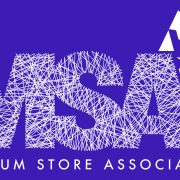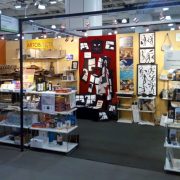MSA Member Dispatches from Home: National Building Museum
April 7, 2020
By Michael Higdon
In these truly challenging and unsure days, all our members are inventing and reinventing ways to sustain their businesses — and themselves. So many of us have had to create new ways to communicate with our colleagues and each other — many, many of them now working at home. As we navigate this time — with no fixed date for a return to normalcy — we would like to offer a series of weekly blogs that are “Dispatches from Home.” Our authors will send ideas about how they are coping with this emergency — with tips, innovations and good humor. We hope that all the varied people in our community help each other, survive and thrive during these incredibly difficult days, and arrive on the other side of this national emergency with their spirits — and businesses — intact.
Working Remotely Is More than a Laptop …
As many of us in the Museum Store Association adjust to working remotely, we are quickly learning that working this way is more than just a laptop, a phone and an internet connection. With so little time to prepare for this sudden transition from our daily customer interaction environment to being at home without the centralized confines of our institution, these unprecedented times have left us to define what working remotely means and what it takes to do so.
Regardless of what you call it — teleworking, mobile work, flex work or just simply working from home — we have suddenly moved into a new environment with its own unique challenges. How do you maintain a culture working remotely that still embodies the collaborative team environment of trust when you are isolated from your team? What technologies are needed to develop this new working environment? How do you make sure the work process supports clarity of the goals to be accomplished? Where do you create a seamless experience in the home that builds on achieving work expectations?
Building an engaging workplace when working remotely is essential for continuing the collaborative environment that supports your team still feeling valued. The first few days of conversations with senior management about remote working was a time warp; it quickly became apparent that assessing who, how and what process would work became a reality. Two of the technologies we chose to use at the National Building Museum were Zoom and Microsoft Teams. Zoom is a web-based video conferencing tool that works with local, desktop client and mobile. At its basic level, Zoom offers both free and for-purchase plans that allow you to meet face to face with your team. Microsoft Teams is a hub for team collaboration that integrates people, content and the tools to allow your team to be more engaged and effective. Both platforms allow for sharing and collaborating in one common place. By adopting both tools, the collaborative environment that embodies the National Building Museum work environment has been maintained outside the museum and in our staff’s homes.
Not all technologies are the same, and not all devices are equal: PC, Mac, iPad, tablet, Android or iPhone. Nothing could be truer as you assess the work environment that staff will need to be physically productive in their homes. In today’s world, owning any one of these devises will allow you to remain connected and will determine the degree to which you might be able to take on home projects that form the remote work environment. In these early days, overcoming and understanding how these all are not the same and learning how to overcome the hurdles that different operating systems that drive the functionality when connecting to different software, servers or the cloud is almost mandatory for the user. Fortunately, at the National Building Museum, we have an excellent team of IT partners who helped many of us overcome the hurdles that we could not ourselves resolve. Getting yourself connected is one thing — but getting multiple people connected takes an enormous amount of fortitude and patience.
Home alone or in the crowded madhouse full of your kids, spouse or whoever you might decide to hunker down with, one thing is for sure: Work has come for a visit in your home, and now you have got to figure out how to deal with this new interloper. Making space to define your work environment is essential to achieving the new expectations of your job. Whether you have the space to set aside a single room, a part of a room or curling up on the sofa with a laptop defining your work environment — when you perform your work responsibilities can prove challenging until you establish some normalcy or routine. While working remotely certainly affords a greater degree of flexibility to perform your work, you must make time and space to do it.
As all our institutions struggle to minimize the impact of the pandemic COVID-19, our rapidly changing work and responsibilities have shifted. Unfortunately, the cause and effect of this pandemic might be that your staff has been laid off. One thing is certain: What we do and how we do it has changed. Fortunately, the National Building Museum has committed to maintaining our staff at present. While this could change at anytime, my role as supervisor remains intact. As a manager, the need to define what work is to be performed by our teams is critical to maintaining the value of our team for our institution. Achieving productivity from a distance requires understanding your process and how these translate to the remote work environment. Adapting and putting into place a remote work environment means defining the expectations of your team, establishing achievable goals and objectives to be accomplished, and accounting for the productivity of our staff. Some questions to keep in mind when building this out:
- Will the employee be working the same hours?
- Will the employee hold the same responsibilities while working from home?
- What times do they need to be available?
- How do they need to be available (phone, email, DMs, etc.)?
- If they are hourly or nonexempt, how will they be tracking their time?
- Will they be required to e-join a team or meetings?
Whatever agreement you come to with your staff, you should make sure you are keeping not only the employee’s needs in mind, but your institution’s needs as well.

Michael Higdon is the retail manager for the National Building Museum in Washington, D.C. An MSA member for more than 20 years, Higdon has served on multiple chapter committees and twice as chapter president. At the national level, he served on the Program Resource Group, the National Program Committee, as a blog writer, a webinar panelist, and he is a four-time session presenter. For the MSA Board of Directors, he has served on the Chapter Policies and Procedures and Governance committees, on the Education Resource Group, as director at large and as secretary.
















Leave a Reply
Want to join the discussion?Feel free to contribute!